This red hot and spicy chutney has its origin in Rajasthani stye local preparation, having obtained the recipe from a village belle I met a long time ago at Jaisalmer. It’is unlike the typical sauces and chutneys available in the commercial market. Far from the typical Schezwan sauce, chilli garlic sauces and branded chutneys that flood the Indian stores.
I managed to wean away the belle’s house recipe, and also had the delight of being offered a hearty homemade meal with it. Of course, information isn’t proferred free of charge as is common in these parts. Barter is the way to earn a favour, and so I picked up a few Rajasthani paintings from her in return for her chilly garlic recipe.
It was while I was at her inconspicuous little store, that I noticed smoke wafting from the rear side of her shop-cum-house which is when I curiously let my eyes follow its trail. Right as rain I was, when I knew there could be no smoke without fire. There were steaming hot rotis being churned out by her mother astride a flat wooden seat, elaborately clad. I wondered how the weight of the numerous bangles didn’t weigh down on her already burdened hands.
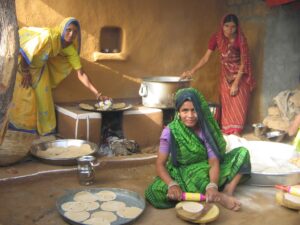 Without doubt I askd for a helping of roti which I swallowed in an instant. But she insisted that I try her “lasun chutney” which she generously slapped on another roti and served together with hot, piping chai. That was the perfect recipe for a wintry evening tea in northern India. It could serve as chutney for momos too, if you can blend it with tomato ketchup. It’s not a common combination to serve lasun chutney for momos, but then it’s great to experiment beyond the tried and tested.
Without doubt I askd for a helping of roti which I swallowed in an instant. But she insisted that I try her “lasun chutney” which she generously slapped on another roti and served together with hot, piping chai. That was the perfect recipe for a wintry evening tea in northern India. It could serve as chutney for momos too, if you can blend it with tomato ketchup. It’s not a common combination to serve lasun chutney for momos, but then it’s great to experiment beyond the tried and tested.
Typically eaten with parathas – mind you it is pronounced nasally as paranthas , the red paste goes well with steamed rice too.
To relive the hot and fiery mood, I offer you my roasted garlic masala chutney recipe.
SPICY CHILLI-GARLIC ROASTED CHUTNEY
Equipment
- Anodised pan
- Mixer-grinder
- Glass sotrage jar
Ingredients
Ingredients
- 1 cup dry, red chillies
- ½ cup oil
- 1 cup garlic (peeled) (avoid using moist/washed garlic to avoid moisture)
- 1 inch ginger (sliced & thoroughly cloth-dried) (to avoid moisture build-up)
- 1 tsp cumin seeds
- 1 tsp coriander seeds
- A large lime-sized ball tamarind (or 2-3 heaped tablespoons)
- 1 tsp salt
- 1/2 tsp hing powder
- ½ tsp Kashmiri red chilli powder (to add a bright red colour)
Instructions
Method
- Remove the stalks from the dry chillies, and deseed them if you don't have a spicy palate. As for me, I deseeded half the quantity of chillies to retain its spicy taste.
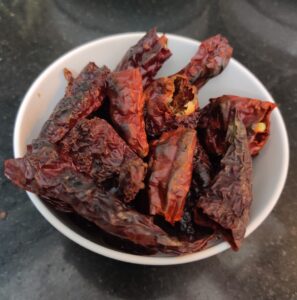
- Dry roast the red chillies in a pan, then keep them aside in a separate bowl when roasted. Ensure that the bowl is dry/ well-dried to avoid moisture build-up that can make the chutney go rancid.
- Pour half a cup oil into the same pan, and heat on medium flame. When heated, take out a couple of teaspoons of oil and set aside for grinding the ingredients. Continue to use the remaining heated oil to sautee the whole peeled garllic and sliced ginger till a pinkish hue.
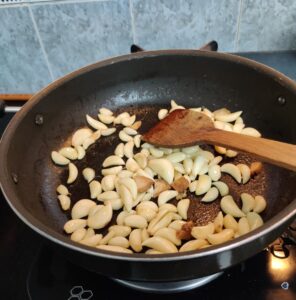
- Next add the cumin seeds, followed by the coriander seeds, and dry tamarind (not soaked). The tamarind acts as a preservative too.
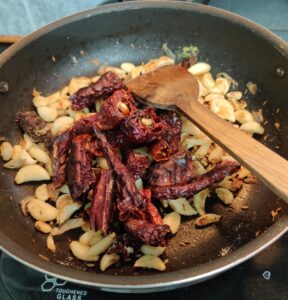
- Sprinkle in a teaspon of salt after a minute of roasting the whole masala and tamarind. Add the hing powder,
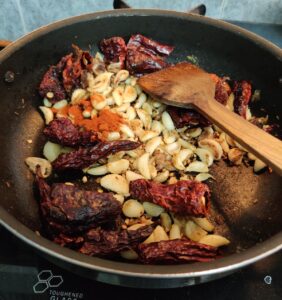
- Roast for a minute, before adding the dry-roasted chillies to the mix and then a little Kashmiri red chilli powder to lend a bright red colour.
- Let cool the roasted ingredients before transferring to a mixer-grinder jar. Add the 2 teaspoons of heated oil that was kept aside in the beginning of the process. Add yet another teaspoon of oil while grinding, if necessary. Grind in stages, opening the grinder to check if more oil is required to give the ground paste a suppleness.
- Grind till the ingredients form a semi-coarse paste, niether too fine nor too coarse. It's imperative that you taste the garlic bits as you eat the chutney. It gives a rustic feel on the palate.
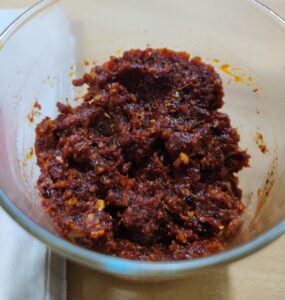
I couldn’t resist replicating the chutney-serving syle as the villagers do, from my last experience at Rajasthan. And so here’s an image of the lasun chilli garlic chutney with roti, whole green chillies and chopped onion which is the closest I could get to the real thing. With the Rajasthani paintings looking at me from the far end of my dining room, it seemed as if I were in the middle of a conventional hamlet.
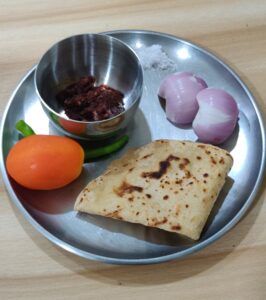


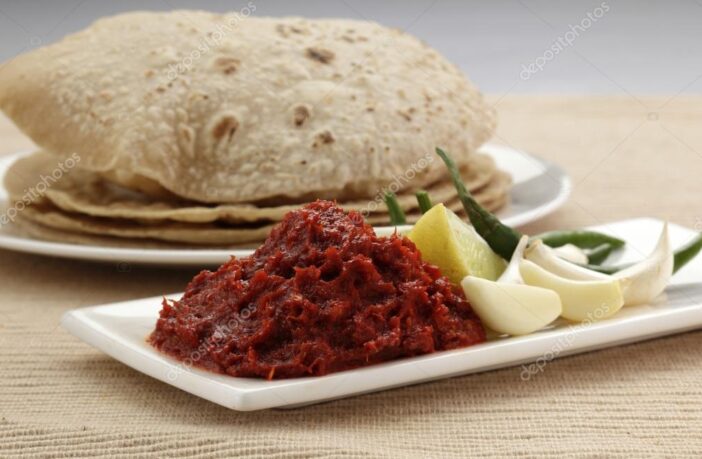
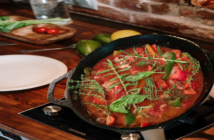
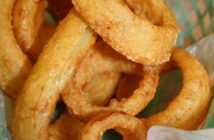
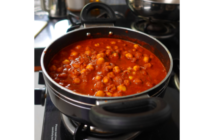
14 Comments
Your article tells a story. You have a penchant for writing, making mundane experiences truly exciting. Will try the recipe. How long can the chutney stay well in the fridge (that’s before going rancid)?
Thank you, Maria, I kept the chutney outside for a couple of weeks and then it didn’t have to stay long in the fridge because we ate one too many chapatis and rice with it for it. It is zingy though.
Absolutely salivating but don’t have the courage to eat all that fire.
Yes, it is a zingy chutney but if eaten in tiny portions with dosa or chapati its spice could get dissipated.
Thanks Carmelita. Can’t wait to try it out. Will keep a fire extinguisher near.
OH am not sure if you, a thoroughbred Goan, will love this recipe. It’s fire in the belly kinda of recipe that would go well with North Indian cuisine. It’s different from the regular chutneys. Don’t say I didn’t warn you.
We need chutneys like these desperately during ‘COVID & Lockdown & Beyond”.
Cooking sound beautiful with Dear LITA!
Oh but this isn’t the typical chutneys that one is used to, this one tastes spicy and has a distinct flavour that’s typically eaten with Indian fare. Thank you, Frankie.
Oh, I thoroughly enjoy the hot hot Tea after the delicious chutney… and the sweating to cool off…
Me too, but not all the time. One has to be in a spicy mood for this kind of a chutney.
I like your style and smooth flow of writing !!!
Thanks, Trevor, it takes effort to make writing appear smooth. Keep commenting!
Such a detailed description, felt like I lived the experience with you. Great going👍
Yeah, it’s the history of the making of the lasun chutney that appealed more than the chutney itself. Thanks for your appreciative comment.